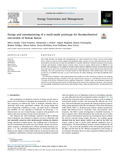JavaScript is disabled for your browser. Some features of this site may not work without it.
| dc.contributor.author | Jurado Pontes, Nelia | |
| dc.contributor.author | Somorin, Tosin | |
| dc.contributor.author | Kolios, Athanasios J. | |
| dc.contributor.author | Wagland, Stuart | |
| dc.contributor.author | Patchigolla, Kumar | |
| dc.contributor.author | Fidalgo, Beatriz | |
| dc.contributor.author | Parker, Alison | |
| dc.contributor.author | McAdam, Ewan | |
| dc.contributor.author | Williams, Leon | |
| dc.contributor.author | Tyrrel, Sean | |
| dc.date.accessioned | 2018-05-04T09:23:22Z | |
| dc.date.available | 2018-05-04T09:23:22Z | |
| dc.date.issued | 2018-03-23 | |
| dc.identifier.citation | Jurado N, Somorin T, Kolios AJ, Wagland S, Patchigolla K, Fidalgo B, Parker A, McAdam E, Williams L, Tyrrel S, Design and commissioning of a multi-mode prototype for thermochemical conversion of human faeces, Energy Conversion and Management, Vol. 163, 1 May 2018, pp. 507-524 | en_UK |
| dc.identifier.issn | 0196-8904 | |
| dc.identifier.uri | http://dx.doi.org/10.1016/j.enconman.2018.02.065 | |
| dc.identifier.uri | http://dspace.lib.cranfield.ac.uk/handle/1826/13186 | |
| dc.description.abstract | This article describes the design and commissioning of a micro-combustor for energy recovery from human faeces, which can operate both in updraft and downdraft modes. Energy recovery from faecal matter via thermochemical conversion has recently been identified as a feasible solution for sanitation problems in low income countries and locations of high income countries where access to sewage infrastructures is difficult or not possible. This technology can be applied to waterless toilets with the additional outcome of generating heat and power that can be used to pre-treat the faeces before their combustion and to ensure that the entire system is self-sustaining. The work presented here is framed within the Nano Membrane Toilet (NMT) project that is being carried out at Cranfield University, as part of the Reinvent the Toilet Challenge of the Bill and Melinda Gates Foundation. For this study, preliminary trials using simulant faeces pellets were first carried out to find out the optimum values for the main operating variables at the scale required by the process, i.e. a fuel flowrate between 0.4 and 1.2 g/min of dry faeces. Parameters such as ignition temperature, residence time, and maximum temperature reached, were determined and used for the final design of the bench-scale combustor prototype. The prototype was successfully commissioned and the first experimental results, using real human faeces, are discussed in the paper. | en_UK |
| dc.language.iso | en | en_UK |
| dc.publisher | Elsevier | en_UK |
| dc.rights | Attribution 4.0 International | * |
| dc.rights.uri | http://creativecommons.org/licenses/by/4.0/ | * |
| dc.subject | Combustion | en_UK |
| dc.subject | Smouldering | en_UK |
| dc.subject | Human faeces | en_UK |
| dc.subject | Micro-combustor | en_UK |
| dc.subject | Updraft | en_UK |
| dc.subject | Downdraft | en_UK |
| dc.subject | Nano-membrane toilet | en_UK |
| dc.subject | Design | en_UK |
| dc.title | Design and commissioning of a multi-mode prototype for thermochemical conversion of human faeces | en_UK |
| dc.type | Article | en_UK |
| dc.identifier.cris | 20301733 |
Files in this item
The following license files are associated with this item:
This item appears in the following Collection(s)
-
Staff publications (SWEE) [2825]

